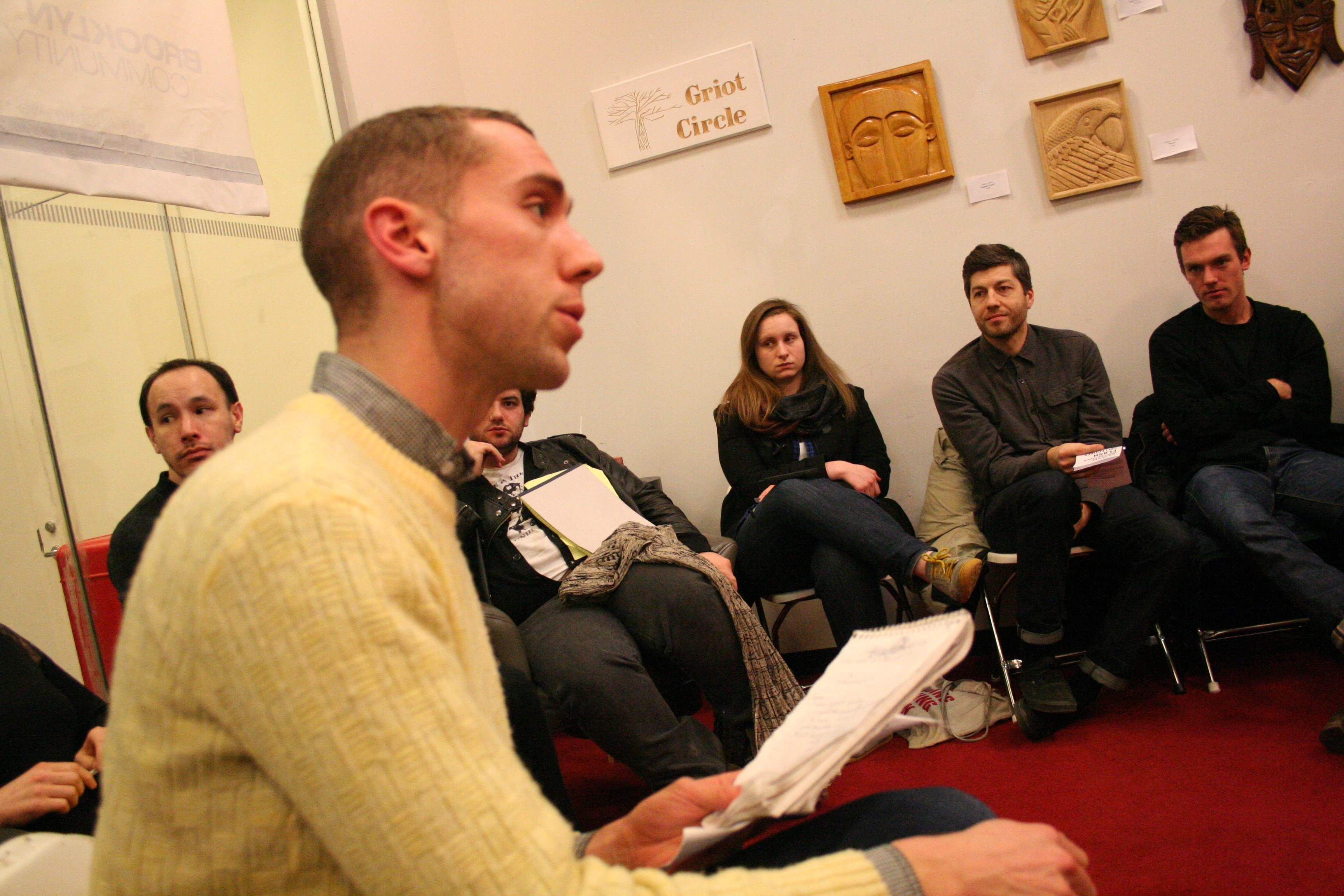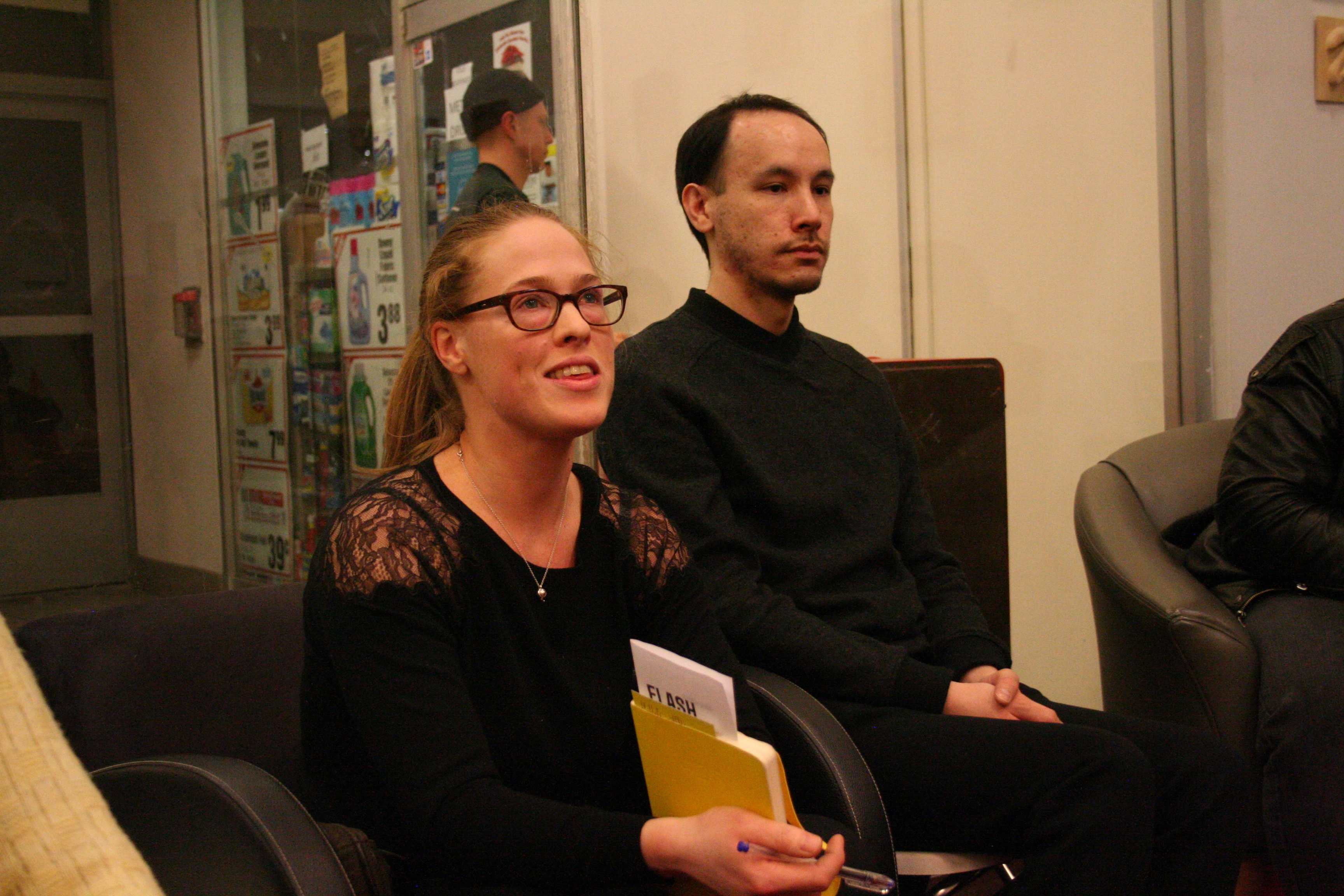
Staff Reflections: Mary Caple on “Flash Collectives: Creating Agile Strategies for Social Change”

photograph by Christopher Conry/Visual AIDS
The author of this post, Mary Caple, is the Administrative Assistant at CEREV and was one of the co-organizers of “Collective Strategies for Visual Production on the Issue of HIV Criminalization.” This workshop took place in the CEREV Exhibition Lab in January 2014 and was led by New York-based artist, activist, and writer Avram Finkelstein. The session was a co-production with Concordia’s HIV/AIDS Community Lecture Series with the support of the university’s Faculty of Fine Arts (FOFA) Gallery. Participants spoke at the Visual AIDS event “Flash Collectives: Creating Agile Strategies for Social Change” on February 28, 2014 at the Brooklyn Community Pride Center in New York.
This February, CEREV hit the road to New York. A month after our extremely productive workshop with Avram Finkelstein, participants from that session took part in a round table discussion titled “Flash Collectives: Creating Agile Strategies for Social Change.” The Brooklyn Community Pride Center and Visual AIDS, a New York based contemporary arts organization dedicated to HIV/AIDS prevention and awareness through art and assistance to artists living with HIV/AIDS, kindly invited myself, my co-organizer Ian Bradley-Perrin, and other workshop participants. The group, including CEREV research affiliate Jenny Doubt, discussed our experiences of organizing and working as a “flash collective” with Avram and a group of about thirty attendees.
The discussion was timely – Ian was part of another panel talk at the New York Public Library that weekend to discuss his own work and take on what Visual AIDS describes as “the role art, representation, nostalgia, memory, history, social media, and the present are playing in the ongoing HIV/AIDS crisis.” These two events in New York were a way for Ian and I to draw upon what I see as some of the strengths of the History department at Concordia, including the public scholarship and interdisciplinary work epitomized by the session with Avram and its new afterlife. At the same time, this was an opportunity to bridge gaps created by departmental and institutional boundaries– even though historical precedent and history in the public sphere were discussed on Friday, the conversation dug into public health, direct action and politics, arts production, and campaign strategies, cross-border parallels and differences, and transnational strategies. And that was only the beginning.

The Friday session began with a discussion of issues surrounding the AIDS epidemic that could be tackled or highlighted using some of the same methodologies and planning strategies we used for the CEREV workshop. A lengthy conversation between people familiar with issues around HIV/AIDS criminalization, laws targeting HIV positive people, PrEP and PEP medication, and access to these, was accompanied by an open comparison of how these issues vary from community to community, city to city, state to state, country to country, and boundaries across and between these units.
Avram discussed his own background working in collectives, emphasizing that the goal for our session was the question of how one can develop grassroots awareness efforts by working intensively and rapidly in response to a community issue with participants who are used to a routine of months of interdepartmental planning, government funding applications, and institutional hoops to jump through before a finished product is complete. At the same time, he stressed how valuable it was to have institutional support – the “collective brain” as he called the CEREV Exhibition Lab, was crucial. In this respect Lex Milton, our Technology and Media Director, must be given kudos for designing a space in which multiple breakaway groups could work with computer programs like PhotoShop and InDesign while keeping the group dynamic and connected by allowing others to see the process through live projections on the Lab walls. While we at CEREV, particularly over the last year, have been pushing the technical capabilities and exhibition possibilities of our Lab space, it was quite a sight to see it used to its fullest capabilities.

Ian and I spoke about the planning process and the use of the CEREV Exhibition Lab as a space for workshopping. I emphasized my main takeaway from the event, which was that one must take into consideration the institutions, organizations, members, and other interested parties the people involved in any given session may have access to. When organizing workshops and collaboration with the goal of creating something, we must take advantage of the opportunity to forge new connections and strengthen old ones, taking advantage of those resources. After all, that’s one of the most valuable parts of being connected to a university – a sense of community and a safe space in which to experiment with innovative ideas. Yes, this sort of strategy takes planning in advance and a certain sense or idea of the types of people who will be present or working together. This isn’t one sided planning, in which one focuses on what the facilitators will do or work on and hope for the best, but a more holistic planning process including participants.
Jenny Doubt and Joshua Valentine rounded out the evening. Jenny shared her thoughts on participating in the session as an academic and researcher who deals with similar subject matter in South Africa, while Josh addressed the difficulties of carrying on the momentum captured in a day’s session for future collaborations.
Many thanks to all involved – “Flash Collectives: Creating Agile Strategies for Social Change” was a special opportunity to reach past the confines of a day, our city, and our community.
Mary Caple is CEREV’s Administrative Assistant and a recent graduate of the Public History stream in the B.A. Honours in History program at Concordia.
Other Links


